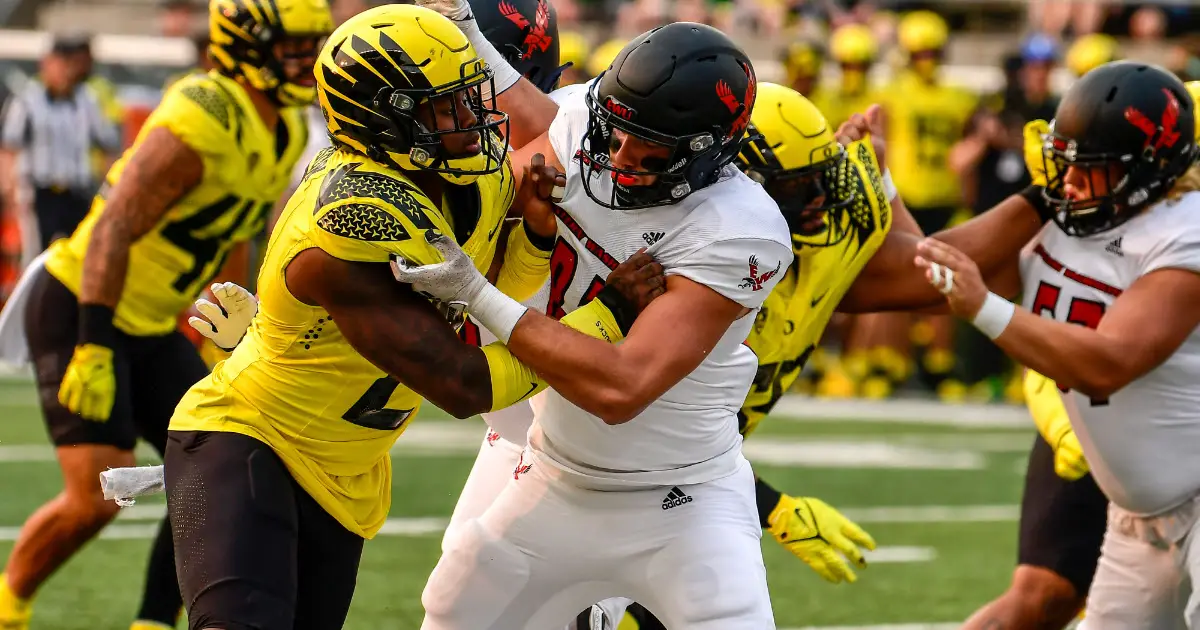You will often hear the phrase, “setting the edge” or a reference to the “force defender” when you watch television football games, and it makes sense to take a few minutes to observe how the new Oregon defense under head coach Dan Lanning, and defensive coordinator Tosh Lupoi fulfill this important mission. How important is it? A Pac-12 team recently won a game on the final play because the opponent’s force defender could not defeat the block and make the stop in time!
Learning this element of defensive football is easy, (it will only take you four minutes below) and watching for it in games and replays will enhance your enjoyment of watching Our Beloved Ducks that much more. Let’s learn some more Oregon football!
On television broadcasts you will hear the term, “run fits” of which are the defensive responsibilities or roles given to particular players in attacking a blocker or ball carrier. (Such as filling a particular gap) A force defender is not a position, but a role in stopping a perimeter play such as an Outside Zone or Sweep. A force defender could be a defensive end, an outside linebacker, a corner or even a safety dependent upon the offensive formation and defense called.
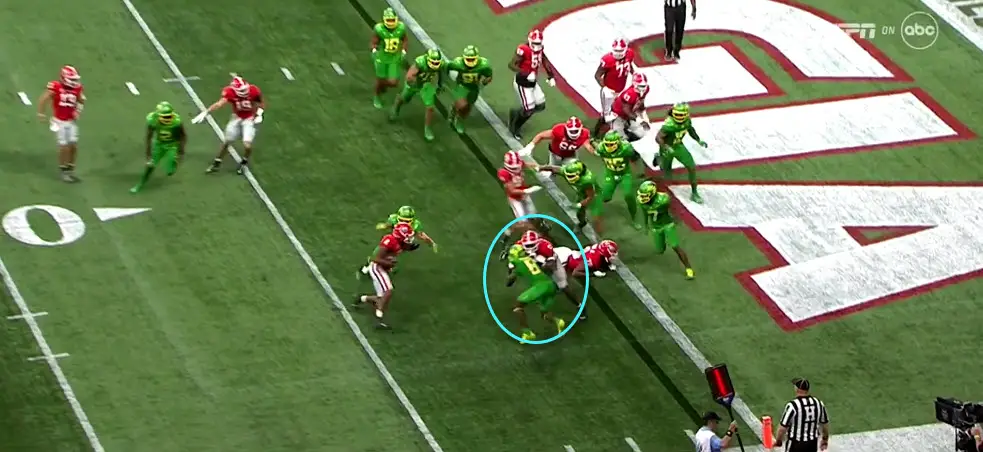
Dontae Manning “forces” the running back inside perfectly.
The objective of the force defender is to set the edge for the defense, and turn the football back inside to the spill defenders who are the interior defensive players (defensive linemen and linebackers) who first stop any inside play, and then “spill” to the outside to help make the tackle. The final part in perimeter defense is the alley defender, who will fit (position himself or fill) between the widest spill defender, and the force defender to stuff the play.
Even the defensive disaster that was the Georgia game had some bright spots for us to learn from, as Dontae Manning (No. 8 above) set the edge as force defender and turned the play inside to the alley and spill defenders to clean up and make the stop.
Watch for this in the first play of the Georgia video a little ways below…
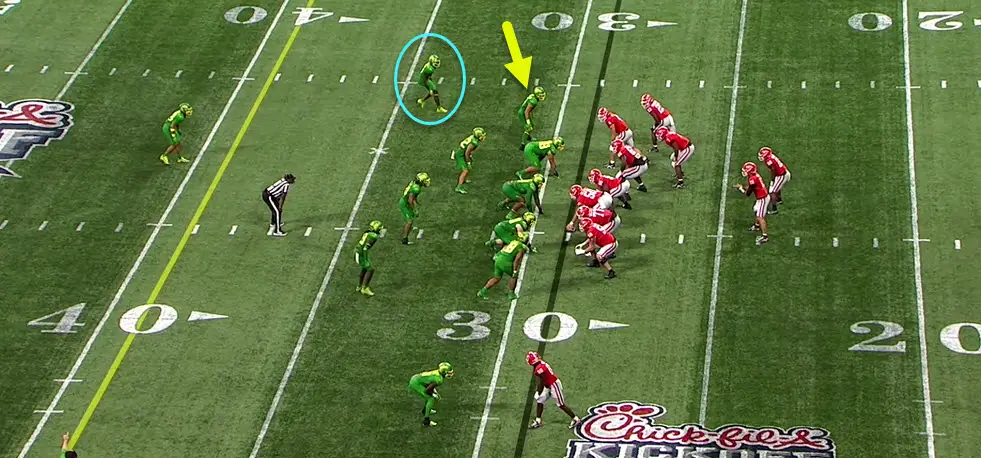
Bennett Williams sacrifices his body for the team, and thus Dontae Manning can make the tackle.
In the second and final play in the Georgia video below, you will see the force defender Bennett Williams, (No. 4 and yellow arrow above) take on the block and widen the play, and thus allow the secondary force player in Dontae Manning (Blue circle above) to make the tackle for no-gain. Watch how they each know their roles, their run-fits extremely well in the Georgia video below…
————————————————————-
Want to read all the Oregon Sports Articles in one place? Check out our new FishDuck Feed for Oregon Sports News and Articles aggregated every day for Duck fans and it is free. Over 50 articles curated in one day recently!
————————————————————-
Any pass-first defenders who are not involved in the primary run fits are secondary force players such as corners that are playing a deep zone, or playing in man coverage, and hence are secondary contain defenders. They do not get involved in defending the run until the ball carrier crosses the line of scrimmage, and trick plays are no longer a threat.
Note how Manning set the edge for others to make the tackle in the first play in the video above, while Williams set up Manning to make the tackle in the second play. Teamwork!
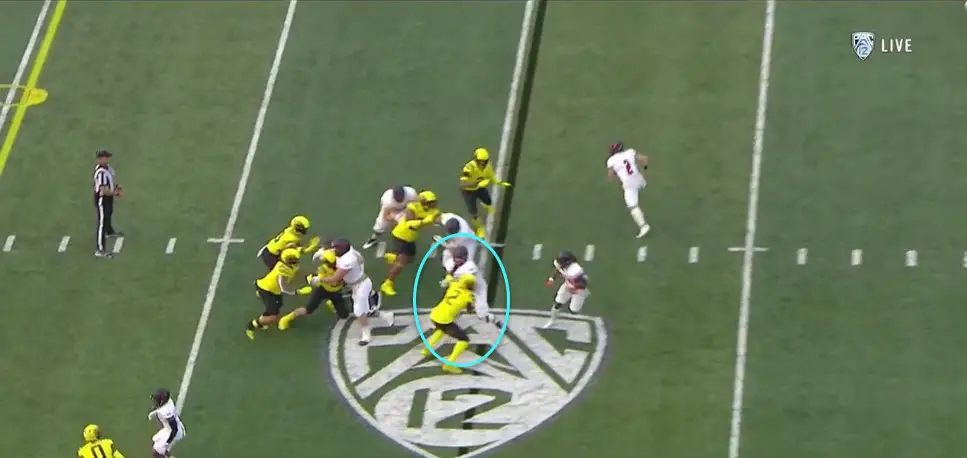
DJ Johnson checks his inside gap first and maintains outside leverage to be the force defender.
There is one force defender on each side of the defense who will attack the outside half of lead blockers, as the force defender is trying to turn the ball carrier back inside to the spill players. Watch for DJ Johnson (No. 2 above) in the first play of the Eastern Washington video a little ways below–check his inside gap responsibility first, and then keep outside leverage on the offensive tackle as you see above.
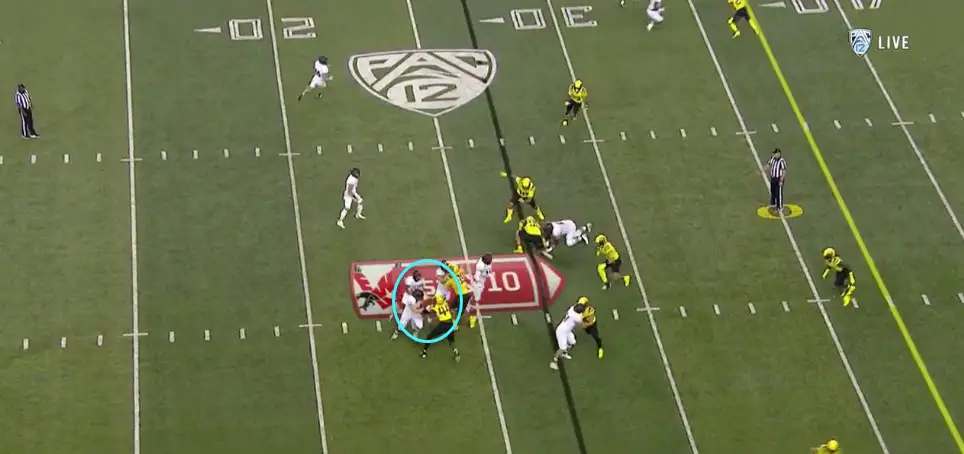
Bradyn Swinson widens the block to turn the running back inside to the alley and spill defenders.
A key to being a force player (also known as a box player or contain player) is to keep your shoulders square to the line of scrimmage, and keep your outside arm and leg free. He must force a change of direction for the ball carrier.
Bradyn Swinson (No. 44 above) does a superb job widening the block so that the running back cannot go outside, and he sees Swinson occupying an inner lane, thus the RB has to turn upfield and take on the spill and alley defenders. Look for the moment you see in the screenshot above in the second and final play of the video below.
Simply being outside is not enough, because if the force defender fits (contains or positions himself) too wide — a running lane is opened up between him and the spill defenders from the inside. Oregon made hay on those cut-back lanes during the Chip Kelly era, thus defenders working together as the spill, alley and force defenders can keep those gaps small and “fit” within them, and thus protect the precious edges of a defense.
So this is what it is to “set the edge” and it will be great fun to watch the Lanning/Lupoi defense implement these principals. It also makes us appreciate the difficulty in blocking for perimeter plays on offense. Watch for this and discuss in the OBD forum because…
“Oh, how we love to learn about Our Beloved Ducks!”
Charles Fischer (Mr. FishDuck)
Eugene, Oregon
Top Photo by Gary Breedlove

Charles Fischer has been an intense fan of the Ducks, a season ticket holder at Autzen Stadium for 38 years and has written reports on football boards for over 26 years. Known as “FishDuck” on those boards, he is acknowledged for providing intense detail in his scrimmage reports, and in his Xs and Os play analyses. He is single, has a daughter Christine, and resides in Eugene Oregon where he was a Financial Advisor for 36 years.
He now focuses full-time on Charitable Planned Giving Workshops for churches and non-profit organizations in addition to managing his two Oregon Football Websites, of FishDuck.com and the Our Beloved Ducks forum. He is a busy man!
He does not profess to be a coach or analyst, but simply a “hack” that enjoys sharing what he has learned and invites others to correct or add to this body of Oregon Football! See More…

